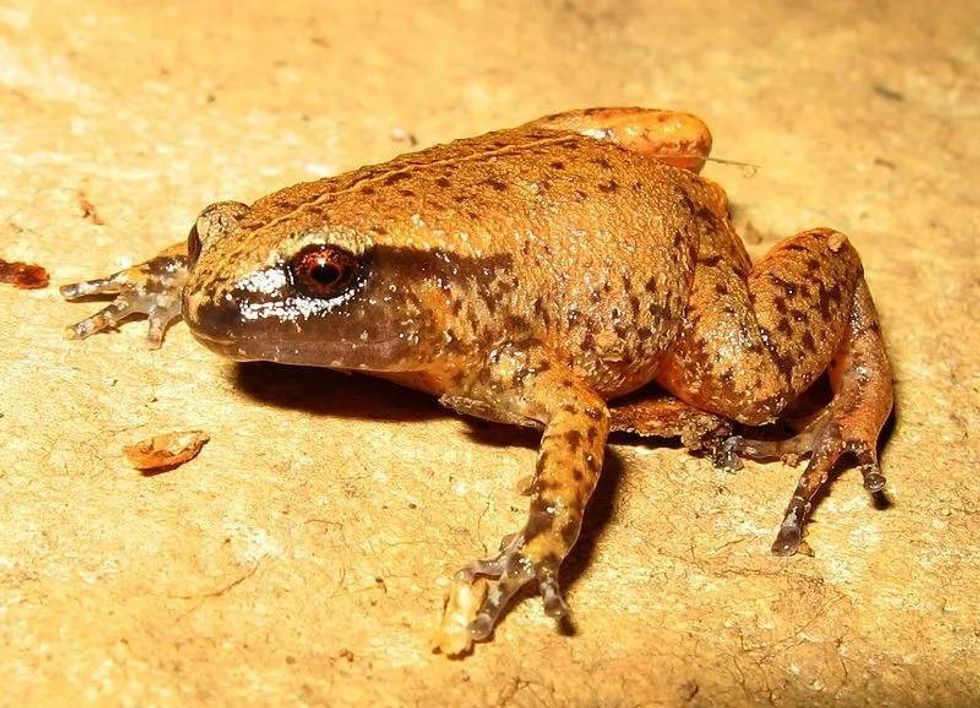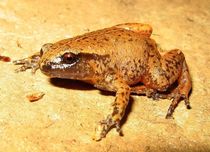The black rain frog (scientific name-Breviceps fuscus), also called the brown short-headed frog, plain rain frog, and Tsitsikama rain frog is of the Brevicipitidae family. The specific scientific term fuscus refers to their dark color.
The species of the genus Breviceps are named short-headed frogs or rain frogs. They occupy semiarid to arid climatic places of South Africa and East Africa. There are 20 species in this genus.
The frogs of this genus walk and do not hop. Rain frogs or Brevicipitidae is a small frog family.
Five genera in this family consist of 34 species as per 2013 data. Phylogenetic data shows that this family should to considered a family within the shovelnose frogs (Hemisotidae) as they are closely related. These frogs are not easily visible as they spend most of their time in leaf litter or soil.
The black rain frog is usually completely black or dark brown. The population of these species is abundant, but they are sensitive to the disturbance of their habitat.
If these facts about the black rain frog were interesting, then do check the Panamanian golden frog and common frog on the Kidadl website.
Black Rain Frog Interesting Facts
What type of animal is a black rain frog?
The black rain frog (Breviceps fuscus), an endemic rain frog species of South Africa of the order Anura and phylum Chordata. This frog is a burrowing nocturnal species. The male frogs call from above the ground and within burrows. Due to this burrowing activity, they are often covered in sand.
These frogs dig out their burrows with their feet and forms tunnels where they escape the heat. This species is also nocturnal. These frogs puff up with air when they are threatened.
What class of animal does a black rain frog belong to?
The black rain frog (Breviceps fuscus) belongs to the Amphibian class of the kingdom animals.
How many black rain frogs are there in the world?
The exact population of the black rain frog (Breviceps fuscus) is not yet calculated.
Where does a black rain frog live?
Breviceps fuscus is an endemic species of South Africa. The natural habitat of this frog species is in the south slopes of the Cape fold belt extending from the Swellendam through the Outeniqua Mountains.
What is a black rain frog's habitat?
The natural habitat of Breviceps fuscus includes forest fringes, forests, mountainous, grasslands, areas, and fynbos. They can easily survive in these natural habitats even without an open water source. The habitat of these species is often determined by the dislodged sand piles due to their burrowing habits. They occupy elevations up to 3,300 ft (1,000 m).
Who does the black rain frog live with?
Breviceps fuscus is a solitary species except in the breeding season.
How long does a black rain frog live?
The exact lifespan of the Breviceps fuscus of South Africa is not known. However, these frogs are very similar to their relatives desert rain frogs (scientific name-Breviceps macrops) who live up to 2-15 years.
How do they reproduce?
The breeding season of the black rain frogs starts in the summer extends through October. Breviceps fuscus has sexual reproduction. This reproduction is dioecious.
Since males are quite smaller than females, the females release a sticky substance to fasten the male onto her body. They lay around 42-43 eggs inside the burrows. These burrows holding the eggs are 1.1-1.5 in (30-40 mm) deep with a small opening. The males guard the eggs often producing calls from above-ground vegetation and within burrows.
The eggs hatch after around two months. These species do not go through the tadpole stage and come out of their eggs as black rain frogs. This is called direct development.
What is their conservation status?
The current conservation status of these species of South Africa is the Least Concern. These frog species are sensitive to habitat destruction.
Even though the conservation status states the population is stable, some threats these frogs face are fires in forests, the spread of alien vegetation, and habitat loss is a huge threat. Currently, their habitats in South Africa are well-protected.
Black Rain Frog Fun Facts
What does a black rain frog look like?
The black rain frogs have a typically dark brown or nearly black round body. Their ventrum is lighter with no pigmented patterns. They have short toes and limbs. Their skin has small tubercles and pitting or pronounced widely spaced granules instead of warts. The second toe of these species is longer than their first and fifth ones.

* Please note that this is an image of a cape rain frog, a relative of the black rain frog. If you have an image of the black rain frog please let us know at hello@kidadl.com.
How cute are they?
These are not considered cute due to their grumpy-looking faces. These species of South Africa are also known as the world's grumpiest frogs.
How do they communicate?
These species communicate using sounds, calls, and chemicals. They have a short call like 'chirp' with a frequency of 1.8 kHz.
How big is a black rain frog?
The snout-vent length of these frogs is 1.6-2 in (40-51 cm). The females are larger than the male species. These frogs are usually small, however, the giant rain frog can grow over 3 in (7.6 cm).
How fast can a black rain frog jump?
The jumping speed of these black rain frogs is not known.
How much does a black rain frog weigh?
The weight of the black rain frog is not known. However, their relatives, desert rain frogs weigh up to 0.25 lb (0.11 kg).
What are the male and female names of the species?
There is no specific name given to the male and female black rain frogs.
What would you call a baby black rain frog?
There is no specific name given to baby black rain frogs. They are referred to as froglets.
What do they eat?
The black rain frog's diet includes spiders, insects, worms, termites, caterpillars, ants, beetles, and other small invertebrates.
Are they poisonous?
No, these species of rain frogs are not poisonous.
Would they make a good pet?
Yes, these frogs would make a good pet. However, this frog needs adequate care and habitat to thrive as a black rain frog pet. They will take time to associate with their owners.
Did you know...
The relatives of these black rain frogs, the Cape rain frog with the scientific name Breviceps gibbosus, was the first rain frog species of Africa to be described by Carl Linneaus. These cape rain frogs are listed as Near Threatened by the IUCN due to decreasing fynbos biomes.
Although these rain frogs are solid in color other rain frogs like the Mozambique rain frog can be found with striking patterns.
At times many of these rain frogs show arboreal characteristics.
The females are known to lay empty eggs on top of the real ones as a decoy to protect the eggs from predators.
Desert rain frogs, relatives of black rain frogs are listed as Endangered species. So, it is not legal to own these species.
Where are black rain frogs from?
The black rain frogs are native and endemic to the forests of South Africa.
What eats the black rain frog?
The natural predators of these rain frogs in their habitat include snakes, red river hogs, and birds of prey. To escape their predators they puff up their body making them seem rounder.
Here at Kidadl, we have carefully created lots of interesting family-friendly animal facts for everyone to discover! Learn more about some other amphibians from our red-eyed tree frog facts and blue poison dart frog facts pages.
You can even occupy yourself at home by coloring on one of our Black Rain Frog coloring pages.
*Please note that the main image is of a rain frog, a relative of the black rain frog. If you have an image of the black rain frog please let us know at hello@kidadl.com.










